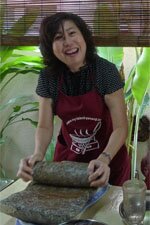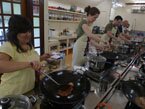The oldest Hindu temple in Penang is The Penang Sri Mariamman Temple. It is also known as Maha Mariamman Temple or Queen Street Indian Temple.
Standing in front the the temple on your right is the Taochiew Association, a UNESCO heritage site. With its back facing Pitt Street is the Goddess of Mercy Temple, and Kapitan Kling Mosque. And a few roads away you have the Khoo Kongsi.
Well, visiting these few prestigious mind blowing sites, don't forget to see the oldest Hindus temple in the island of Penang, the Penang Sri Mariamman Temple.
In those days, it was done to ensure the Indian community, which includes the early working settlers like merchants and laborers are settled in one area to ease managing them.
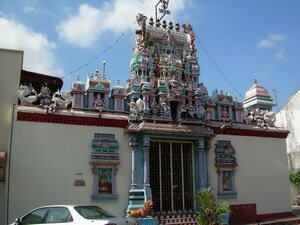
By 1833, the shrine through the efforts of the Indian settlers, turned to a temple and was renovated to its present form a hundred years later.
The main deity is a deity called Amman or Maha Mariamman, worshipped as the mother of the universe by Hindu devotees. On the entrance of Penang Sri Mariamman Temple, you get to see a 23 feet tall sculptured tower or Gopuram.
Also the 38 statues of Gods and Goddesses and four swans featuring the Hindu Goddess Mariamman in Her many incarnations surrounds the colorful four-tiered crown.
With subsequent renovations carried out over the years by Hindus artisans and sculptors from India and locals, from makeshift huts to heavily ornate and brightly shining with diamonds and precious stones, Penang Sri Mariamman Temple is a sight to behold.
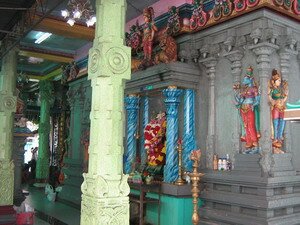
The interiors of the temples are heavily sculptured with deities of Lord Muruga. Many statues of deities, gods and goddesses can be seen on the walls surrounding the inner shrine of Penang Sri Maha Mariamman Temple.

Like most Indian temples in Penang, the Penang Sri Mahariamman began as a small and simple shrine.
The land was granted in 1801 by the British to Betty Lingam Chetty, who was then the Kapitan (Headman, Kepala or Community Leader) of the Tamils and South Indians.
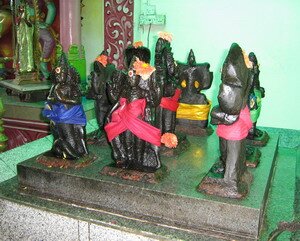
Historians claimed that the worship of Sri Maha Mariamman started as a tribal religion of the Dravidians.
There are also shrines for sub deities Techinamoorthy, Ganapathy, Subramaniam, Durga, Chandikeswarar, Bairavar and Navakeragam in Penang Sri Mariamman Temple.
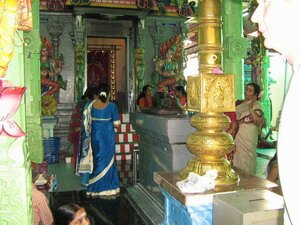
I was told the word Mariamman come from two words. "Mari" meaning "power" and "amman" meaning "mother". So this temple tells you, it houses a powerful mother.
And some Indians considers Sri Mariamman to be the mother of Lord Muruga and Ganesha. So to many locals, when asks which temple they are going, some simply said "Amman Temple".
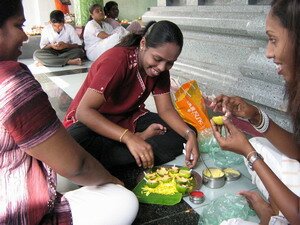
Visitation to this temple is limited to morning and evening. Morning pujas (prayers) starts from 6am and evening from 5pm. The temples closes after the prayers are performed.
Daily, there will be Pujas held in mornings and evening. On special days like Tuesday, devotees will be vegetarians for the day.
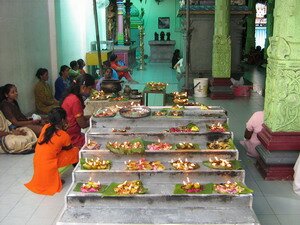
Young ladies wanting to marry will come to offer prayers asking from the "mother" for a good husband. Married ladies will pray for a successful marriage.
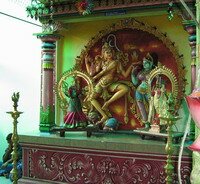
But overall lots of locals, men or women come here to pray as she is supposedly the mother of Lord Rama, Muruga or Ganesha, Shiva forms in their many incarnations.
Most auspicious event for the temple is the Navarithri festival. Usually a procession where the deity Mariamman is paraded in a decorated wooden chariot through the streets of Little India. (Navarathri is nine nights vegetarian festival).
According to the Hindu Puranas (holy books), the festival is held to commemorate the victory of Goddess Parasakthi over the demon king Mahishasuran.
It was stated that the evil king ill-treated the people that they turned to the goddess, who is the consort of Lord Shiva, to save them.
Goddess Parasakthi fought a battle for nine days and ultimately destroyed him on the 10th day, which is known as Vijayathasami day.
Go to Top of Penang Sri Mariamman Temple Page
Back to My Island Penang Home Page







